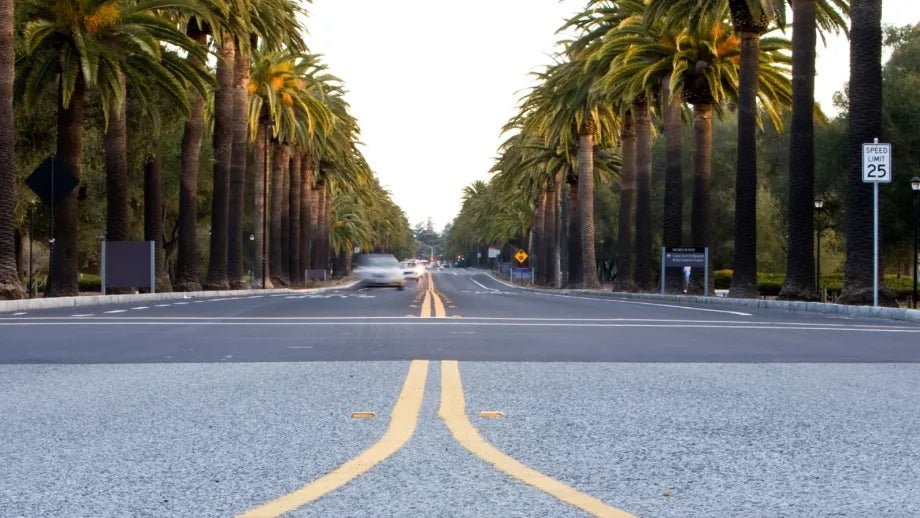Bay Area Streets and Roads Show Resilience As Cities, Counties Receive New Gas Tax Dollars
Bay Area cities and counties largely managed to prevent further deterioration of their local street and road networks in 2017. Data released today by the Metropolitan Transportation Commission (MTC) show the region’s 43,000 lane-miles of local streets and roads registered an average pavement condition index (PCI) score of 67 out of a maximum possible 100 points last year, as calculated on a three-year moving average basis. This marks the second year in a row that the regional average has reached 67 points, and reflects a slow but steady upward trend in which the Bay Area’s average pavement score has climbed four points since 2003.
“MTC’s goal is to bring all of the Bay Area’s transportation assets into a state of good repair,” explained MTC Chair Jake Mackenzie, who also serves as a Rohnert Park city councilmember. “For local streets and roads, that would mean boosting the regional average PCI score to about 85 points. So it’s good to see the needle move in the right direction, and to see it moving faster now that cities and counties are receiving new gas tax money and other funds from last year’s Senate Bill 1 transportation package. But the typical Bay Area street is still pretty worn and likely to soon need some serious work. I hope voters will keep streets and roads in mind when they consider Proposition 6 on the November ballot.”
PCI scores of 90 or higher are considered “excellent.” These are newly built or resurfaced streets that show little or no distress. Pavement with a PCI score in the 80 to 89 range is considered “very good,” and shows only slight or moderate distress, requiring primarily preventive maintenance. The “good” category ranges from 70 to 79, while streets with PCI scores in the “fair” (60-69) range are becoming worn to the point where rehabilitation may be needed to prevent rapid deterioration. Because major repairs cost five to 10 times more than routine maintenance, these streets are at an especially critical stage. Roadways with PCI scores of 50 to 59 are deemed “at-risk,” while those with PCI scores of 25 to 49 are considered “poor.” These roads require major rehabilitation or reconstruction. Pavement with a PCI score below 25 is considered “failed.” Among the region’s three largest cities, San Francisco last year entered the “good” category by raising its three-year moving average score from 68 to 70, while San Jose (64) and Oakland (55) remained in the “fair” and “at-risk” classifications respectively.
“Thanks to generous Oakland voters who passed Measure KK, our city’s roads are finally getting the paving they desperately need,” said Oakland Mayor and MTC Commissioner Libby Schaaf. “We just wrapped up our Summer of Paving, rolling out 25 miles of new city roads, and now we need to keep the momentum going. SB 1 is a critical resource that ensures millions of dollars a year for road fixes in Oakland, where every resident, in every neighborhood, deserves a smooth ride.”
The Alameda County city of Dublin once again topped the list of Bay Area pavement rankings for the 2015-17 period, reporting an average PCI score of 85. Other cities with three-year PCI scores in the “very good” range include Clayton and El Cerrito (84); Brentwood, Colma and Palo Alto (83); Foster City (82); Daly City, Union City and unincorporated Solano County (81); and San Ramon (80).
The lowest-ranked pavement in the Bay Area was found in the Marin County city of Larkspur, which recorded a PCI score of 42 for 2015-17. Other jurisdictions with three-year average PCI scores in the “poor” range include Petaluma (46) and unincorporated Sonoma County (49).
MTC later this year will recognize Solano County for having the best overall pavement management strategy of any Bay Area jurisdiction, the city of Dublin for its consistently high pavement quality scores and the city of Martinez for raising its one-year PCI score by 16 points to 61 from just 45 in 2016.
The complete 2017 Pavement Conditions Summary — including percentages of local roadways in various conditions, and a listing of average PCI scores for the arterials, collector roadways and residential streets — for all Bay Area counties and cities is featured in a newly-updated MTC publication entitled The Pothole Report: Bay Area Roads at Risk.
In addition to the complete 2017 Pavement Conditions Summary, the new Pothole Report includes a primer on the cost and lifecycle of pavement; a review of the new statewide Road Maintenance and Rehabilitation Program established last year by SB 1; analysis of the impact voter approval of Proposition 6 would have on cities’ and counties’ pavement maintenance programs; and a spotlight on the specific pavement-management challenges facing Sonoma County and the vast network of roadways in the unincorporated portions of the county.
MTC’s Vital Signs website provides even more detailed information on pavement conditions in each of the Bay Area’s nine counties and 101 cities, including both block-by-block analyses and a record of every municipality’s average PCI score for each year from 2003 through 2017.
MTC is the transportation planning, financing and coordinating agency for the nine-county San Francisco Bay Area.

